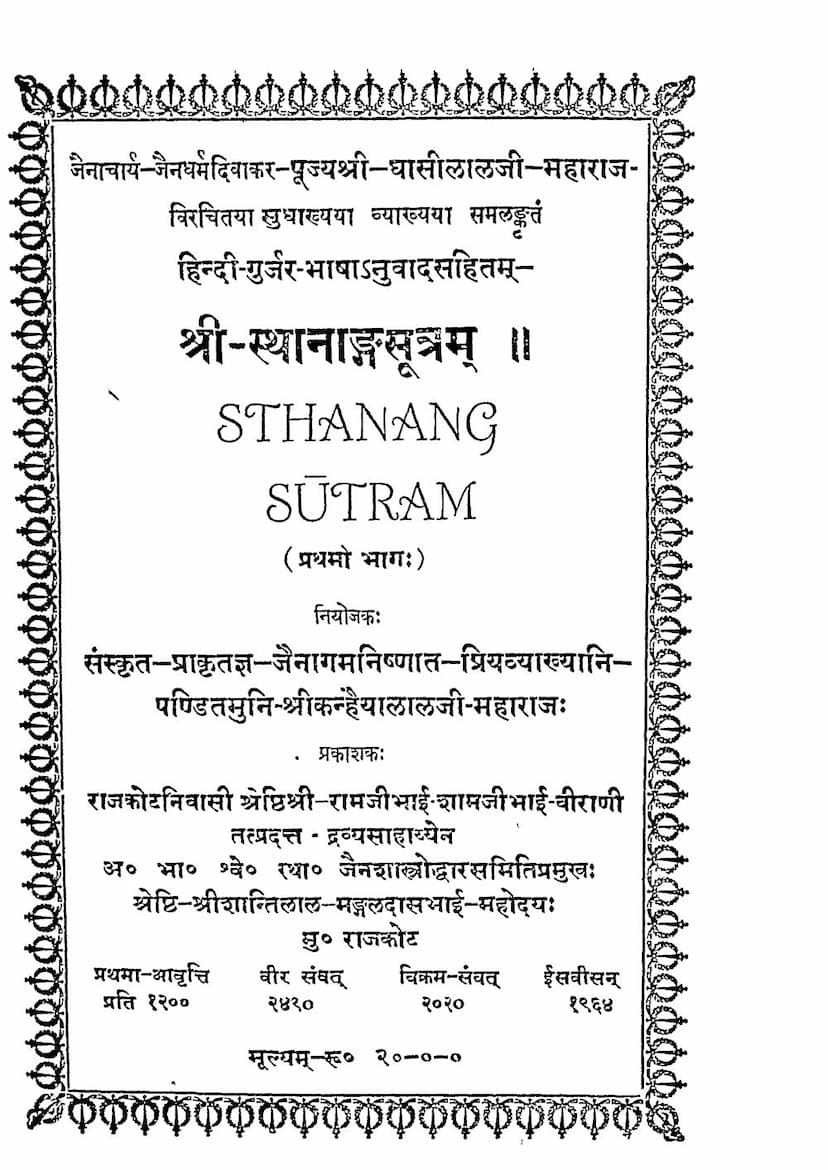Sthanang Sutram Part 01
Added to library: September 2, 2025

Summary
Sthananga Sutra Part 01 - A Comprehensive Summary
This summary provides an overview of the initial parts of the Sthananga Sutra, based on the provided text. The Sthananga Sutra is a foundational text in Jainism, particularly within the Shwetambar tradition, and it systematically categorizes various aspects of Jain philosophy and practice. The provided text, "Sthananga Sutram Part 01," compiled by Ghasilal Maharaj and published by A B Shwetambar Sthanakwasi Jain Shastroddhar Samiti, seems to be a detailed commentary and translation of the original text.
Overall Structure and Purpose:
The Sthananga Sutra is structured around the concept of "Sthanas" or "places" which refers to numerical categories. It aims to classify and enumerate all phenomena of the universe according to Jain principles. Part 01, as presented here, appears to cover the initial "Sthanas" (places) and their detailed exposition.
Key Themes and Contents (Based on provided pages):
The provided pages reveal a multi-faceted approach to understanding Jain doctrine. Here's a breakdown of the prominent themes:
-
Commentary and Translation: The text is not just the Sutra itself but a detailed commentary ("Sudha" in Sanskrit) with Hindi and Gujarati translations, indicating a pedagogical or explanatory purpose. The presence of multiple languages suggests an effort to make the text accessible.
-
Praise and Acknowledgement:
- Author: Acharya Jain-Dharmadivakar Pujyashri Ghasilalji Maharaj is credited as the author.
- Editor/Supervisor: Muni Shri Kanahayalalji Maharaj, a Sanskrit-Prakrit scholar and expert in Jain Agamas, is listed as the supervisor.
- Publisher: Shri Akhil Bharat Shwetambar Sthanakwasi Jain Shastroddhara Samiti, with significant financial support from Shreshti Shri Ramjibhai Shamjibhai Chirani of Rajkot, is the publisher.
- Dedication: Pages 3, 9, 10, 11, 12, and 13 show photographs and names of various patrons and elders ("AadhMubbiShreeo"), highlighting the collaborative effort and community support behind the publication. Page 5 specifically provides a detailed biography of Shri Ramjibhai Shamjibhai Virani, emphasizing his philanthropy and religious devotion.
-
Core Jain Concepts: The text, through its meticulous breakdown, delves into fundamental Jain concepts:
- The Nature of the Soul (Atma): The text explores the soul's oneness and its characteristics.
- Dharma and Adharma: These fundamental principles of Jain cosmology are discussed.
- Consciousness and Knowledge (Jnana): Different types and aspects of knowledge are analyzed.
- Karma and Its Effects: The text touches upon the bondage of karma and its various manifestations.
- Liberation (Moksha): The ultimate goal of Jainism is implicitly or explicitly discussed.
- The Universe: The structure of the cosmos, including concepts like Lok, Alok, and the different regions (like Naraka, Deva, Manushya), is likely explored in detail.
- Ahimsa and Ethical Conduct: The principles of non-violence and the conduct of monks and householders are central. The detailed mention of donation activities by patrons further underscores the importance of ethical living.
- Categorization and Enumeration: The "Sthananga" nature of the sutra implies a systematic classification of realities into various numerical categories (e.g., one soul, two kinds of actions, etc.). Page 14 onwards provides a detailed "Anukramanka" (Table of Contents) listing various "Sthanas" and their respective topics, giving a glimpse into the exhaustive enumeration.
-
Mangalacharan (Invocation): Page 19 begins with a "Mangalacharan" (auspicious invocation) in Malini meter, praising Lord Mahavir and invoking his blessings. This is followed by an interpretation of the verse, highlighting the path to self-realization and the meaning of "Mahavir."
-
Gautama Swami's Role: The text mentions the importance of Gautam Swami, the chief disciple of Lord Mahavir, in disseminating the teachings after the latter's Nirvana, emphasizing the continuity of the spiritual lineage.
-
The Number 'One' (Ek) as a Recurring Theme: Several "Sthanas" begin with the concept of "Ek" (one), signifying the fundamental oneness or singularity of certain entities or principles. For instance, "Eke Aaya" (One Soul), "Eke Sthane" (One Place), "Eke Bande" (One Bondage), etc., are seen in the table of contents. This suggests a foundational emphasis on singularity before exploring multiplicity.
-
The Importance of Naya (Viewpoint): The text implicitly refers to the complexity of Jain philosophy by mentioning the need for understanding "Naya" (viewpoints) to grasp the true meaning of the teachings, similar to how a milkmaid extracts ghee from curd.
In essence, the provided text of Sthananga Sutram Part 01 is a significant work that:
- Systematically categorizes Jain philosophical and cosmological concepts.
- Offers a detailed commentary and translations for wider understanding.
- Highlights the deep reverence for spiritual masters and community support.
- Begins with an auspicious invocation and emphasizes the path of self-realization.
- Underscores the foundational Jain principles through a structured, numerical approach.
This summary is based on the provided pages and table of contents. A complete understanding would require access to the entire text and its deeper analysis.